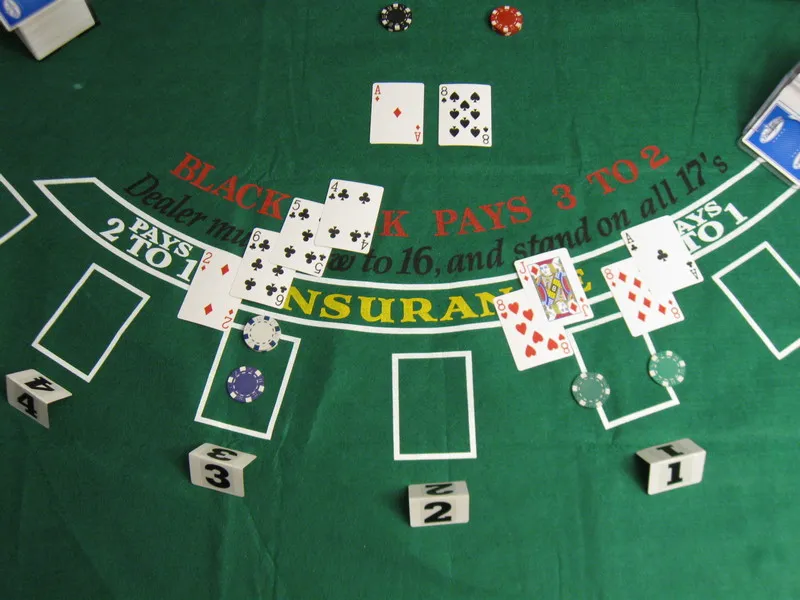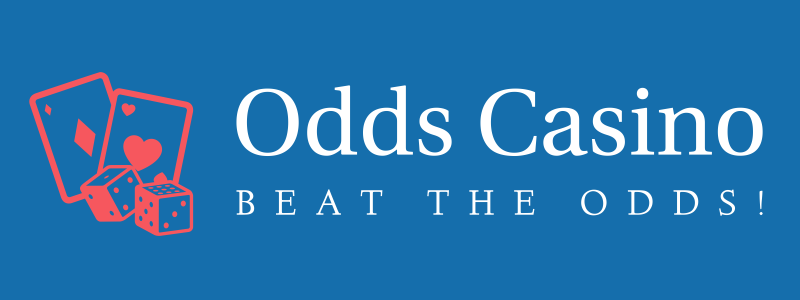Blackjack

History of Blackjack
BlackJack is the most popular banked card game in the world. It is also called Twenty one, Vingt et un, Twenty one, Pontoon, Vanjohn. The first appereance of the game is back to the early 17th century in Spain: the famous writer Miguel de Cervantes (a gambler himself) talked about this game in one of his most successful novel.
Then the game spread very quickly everywhere with only minor differences (and names). In France was spotted in 1768 and in UK almost at the same time. Even the US where “hit” by this game and they made some modifications to the UK rules in 1899, changing the name in Blackjack!
What You Find On the Blackjack Table.
A regular blackjack table can have five to nine betting spaces on the tableau. Then there is a box of chips and a card dispenser with a waste container. There can be one, two, three or even four decks of cards shuffled together with two blank cards to use as indicators (one to cut the deck and one to signal the end of the shuffled cards).
Rules of Play of Blackjack At the Casino
The enormous success of this game is due to its simplicity and speed. From behind a semicircular table, the dealer faces five to nine playing positions.
Between one and eight standard 52-card decks are shuffled together. To start each round, players place bets in the “betting box” at each position. In jurisdictions allowing back betting, up to three players can be at each position. A player can control or bet in as many boxes as desired at a single table, but an individual cannot play on more than one table at a time or place multiple bets within a single box. In many U.S. casinos, players are limited to playing one to three positions at a table.
But why are there some restrictions and different rules depending on which casino you go to? Because of the House Edge. Blackjack is one of the favorite games of serious players because it has the lowest odds in favor of the house of all the games the casino can offer.
Shuffling and cutting cards
At the very beginning of the game, when the table is open, the Croupier starts “Shuffling and Cutting” the cards. Only the croupier shuffles the cards, who can shuffle them at any time. After  he shuffles them, he offers the deck to one of the players to cut it. The cut of the deck is done by means of an indicator card (white) that the player places where he wants in the deck. In many casinos, the dealer inserts a second marker card about 40 cards from the end of the deck to prevent the last cards from coming into play. If a container is used, the dealer places the deck face down in it, then brings out some cards (usually three) from the top of the deck and sets them aside, excluding them from the game.
he shuffles them, he offers the deck to one of the players to cut it. The cut of the deck is done by means of an indicator card (white) that the player places where he wants in the deck. In many casinos, the dealer inserts a second marker card about 40 cards from the end of the deck to prevent the last cards from coming into play. If a container is used, the dealer places the deck face down in it, then brings out some cards (usually three) from the top of the deck and sets them aside, excluding them from the game.
Dealer Rules:
The dealer must stand if his score is 17 or more. If his count is 16 or less, the dealer must draw. When he has an Ace in his hand he must accept the Ace’s count as 11 and if it gives him 17 or more, without busting, he can no longer draw. Since the dealer has no choice in his game, it does not matter whether or not he sees players’ hands. For this reason, in some casinos, players’ hands are dealt face up.
When a player and the dealer have an equal score, the player’s stake is always returned.
Black Jacks are paid 3 to 1.
Try and Play Blackjack For Free With Us!
Bets and Distribution
How do you distribute cards in blackjack? Before the cards are distributed, each player (dealer excluded) places his bet on the tableau, in the space provided in front of him. As we mentioned before, if multiple slots are available, as is the case in most casinos, the player has the option to bet on more than one, and to receive more than one hand. The dealer gives a card to each player, starting with the one to the left of him, and going clockwise, then gives himself a card.
Then, again in the same way, he deals a second card. Cards can be dealt face down or face up, depending on the casino.
There could be the possibility that the dealer’s face up card is 10 points, or is an Ace, so he looks at his hole card to see if he has Black Jack.
In case the dealer did Black Jack, he immediately collects the bets of the players who did not Black Jack, instead he returns the stake to whoever did it.
On the contrary, when the croupier’s up card is not 10 points, nor is it an Ace, or if the dealer hasn’t made Black Jack, the game starts with the player to his left.
Starting the Blackjack Game
The player to the left of the dealer looks at his hand and starts the game. Then what happens if:
- his card total is 21 points, he bids Black Jack and is paid by the dealer, unless the dealer has also done Black Jack;
- the total of the cards is less than 21, the player has the option of deciding whether to take more cards;
- the player has the impression that the sum of his cards is closer to 21 than the dealer can have, he can say “I’m” and not receive any more cards;
- he instead decides to get closer to 21, he can say “hit” and receive another card face up. He can keep calling until he is satisfied with his hand and then he will say “I’m”. However if the hand point total is over 21, he must announce it immediately by saying “I’m bust”;
- a player busts must reveal their cards, the dealer collects his stake and the cards are placed face up on the bottom of the deck. He then he will remain out of the game until the next hand. If a player occupies more than one seat and therefore plays more than one hand, he must complete the play of the hand furthest to his right, before looking at the next hand or hands.
Variants of the Distributions
Depending on different Casino rules, there are different possible distributions:
- first card of all the players and of the dealer face down. Second card face up.
- first card of the dealer face up, second face down. For the players, first and second cards face down.
- first card of the dealer face up, second face down. First and second player cards face up.
- the dealer’s first card face down. First and second player cards face up.
- dealer’s first card face up, second face down. First card of the players covered, second discovery.
Betting Limits
The casino sets the maximum and minimum betting limits. Often the casino agrees to raise the maximum at the request of the players.
Black Jack can be played in two versions: with alternate bank and with permanent bank. This latest version is the one in use in all casinos around the world.
Players Decisions in Blackjack Game
As soon as the player gets the first two cards, he/she has up to five options:
(*Each player decision has a specific signal)
- HIT –> Take another card. Signal: He can say “hit” or knocking with the finger on the table.
- STAND –> Take no more cards; also known as “stand pat”, “sit”, “stick”, or “stay”.
Signal: Slide cards under chips (in handheld games); wave hand horizontally (in games dealt face up). - DOUBLE DOWN –> Increase the initial bet by 100% and take exactly one more card. The additional bet is placed next to the original bet. Discovering his cards, he doubles his original stake and receives a single card face down that he will not have the right to look at until the dealer reveals it, after all the other players (including the dealer) have completed their turn. There can be different Casino rules and sometimes doubling is only allowed when the total of the two cards is 10 or 11 points.
Signal: Place additional chips beside the original bet outside the betting box and point with one finger. - SPLIT –> Create two hands from a starting hand where both cards are the same value. The two cards can be considered as the basis of two separate hands. When it’s his turn, the player with the pair turns them face up and places a card to his right and one to his left. Then he places the original stake on one of the two cards and a new stake, equal to the first, on the other. Each new hand gets another card so that the player has two starting hands. This requires an additional bet on the second hand. The two hands are played out independently, and the wager on each hand is won or lost independently. If by receiving a new card, which is not an Ace, the player forms a new pair, he can also separate this, as long as he always puts into play a new stake equal to the original one.
When he is done, the player receives another face up card assigned to the left card, and plays that hand as well. All consecutive couples can be separated. A specific rule exists when a pair of Aces is separated: only one card can be received for each Ace. A total of 21 points reached by two cards after the split does not count as Black Jack, it is therefore paid even money.
Signal: Splitting card on the left and right. - SURRENDER –> Forfeit half the bet and end the hand immediately. This option is only available at some tables in some casinos, and the option is only available as the first decision.
Signal: Spoken, there are no standard signals.
Insurance Bet.
There is the possibility that the dealer has a Blackjack (21) without even starting the game if the up card is an Ace. For that reason, in many casinos players have the option of placing an “insurance” bet. So before the dealer checks his hole card, the player who intends to insure puts in play a stake equal to half his stake at that moment. If the dealer hits Blackjack, the player’s insurance bet is paid 2 to 1, otherwise it is lost.
Following Hands: Once a player says “I’m” or “I’m busted,” the game is played
Dealer’s Hand.
The dealer plays last. If all players are busted, he throws his cards and starts a new hand. Otherwise he reveals his hole card and decides to “stay” or “draw” (ie to give himself other cards face up) until he is satisfied or exceeds 21 points and busts.
| Number of decks | House advantage |
|---|---|
| Single deck | 0.17% |
| Double deck | 0.46% |
| Four decks | 0.60% |
| Six decks | 0.64% |
| Eight decks | 0.66% |
